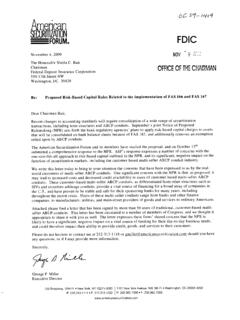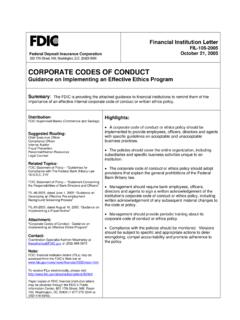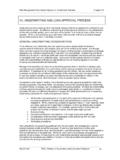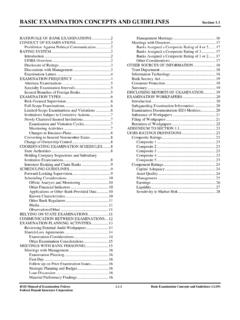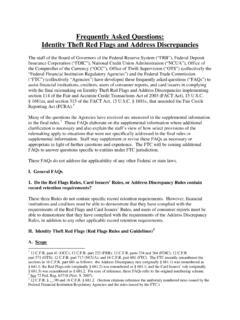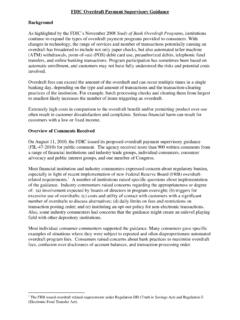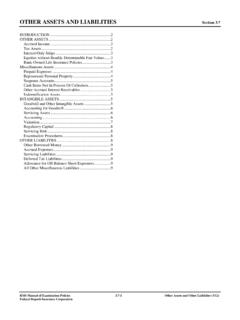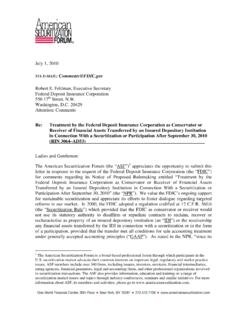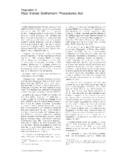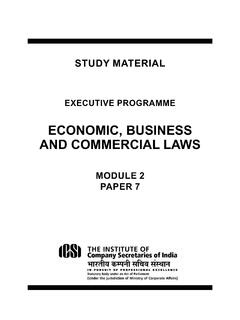Transcription of V. Lending — RESPA
1 V. Lending RESPA real estate Settlement Procedures Act ( RESPA ) Introduction The real estate Settlement Procedures Act of 1974 ( RESPA ) (12 2601 et seq.) (the Act) became effective on June 20, 1975.
2 The Act requires lenders, mortgage brokers, or servicers of home loans to provide borrowers with pertinent and timely disclosures regarding the nature and costs of the real estate settlement process. The Act also prohibits specific practices, such as kickbacks, and places limitations upon the use of escrow accounts. The Department of Housing and Urban Development (HUD) originally promulgated Regulation X, which implements RESPA . Congress has amended RESPA significantly since its enactment. The National Affordable Housing Act of 1990 amended RESPA to require detailed disclosures concerning the transfer, sale, or assignment of mortgage servicing.
3 It also requires disclosures for mortgage escrow accounts at closing and annually thereafter, itemizing the charges to be paid by the borrower and what is paid out of the account by the servicer. In October 1992, Congress amended RESPA to cover subordinate lien loans. Congress, when it enacted the Economic Growth and Regulatory Paperwork Reduction Act of 1996, 1 further amended RESPA to clarify certain definitions, including controlled business arrangement, which was changed to affiliated business arrangement. The changes also reduced the disclosures under the mortgage servicing provisions of RESPA .
4 In 2008, HUD issued a RESPA Reform Rule (73 Fed. Reg. 68204, November 17, 2008) that included substantive and technical changes to the existing RESPA regulations and different implementation dates for various provisions. Substantive changes included a standard Good Faith Estimate (GFE) form and a revised HUD-1 Settlement Statement that were required as of January 1, 2010. Technical changes, including streamlined mortgage servicing disclosure language, elimination of outdated escrow account provisions, and a provision permitting an average charge to be listed on the GFE and HUD-1 Settlement Statement, took effect on January 16, 2009.
5 In addition, HUD clarified that all disclosures required by RESPA are permitted to be provided electronically, in accordance with the Electronic Signatures in Global and National Commerce Act (E-Sign).2 The Dodd-Frank Wall Street Reform and Consumer Protection Act, Pub. L. 111-203 (July 10, 2010) (Dodd-Frank 1 Pub. L. 104-208, Div. A., Title II 2103 (c), September 30, 1996. 2 15 7001 et seq. Act) granted rule-making authority under RESPA to the Consumer Financial Protection Bureau (CFPB) and, with respect to entities under its jurisdiction, generally granted authority to the CFPB to supervise for and enforce compliance with RESPA and its implementing In December 2011, the CFPB restated HUD s implementing regulation at 12 CFR Part 1024 (76 Fed.)
6 Reg. 78978) (December 20, 2011). Since December 2011, the CFPB has issued a series of final rules amending Regulation X. On January 17, 2013, the CFPB issued a final rule that implemented certain provisions of Title XIV of the Dodd-Frank Act and included substantive and technical changes to the existing regulations. (78 Fed. Reg. 10695) (February 14, 2013). Substantive changes included modifying the servicing transfer notice requirements and implementing new procedures and notice requirements related to borrowers error resolution requests and information requests.
7 The amendments also included new provisions related to escrow payments, force-placed insurance, general servicing policies, procedures, and requirements, early intervention, continuity of contact, and loss mitigation. The amendments were effective as of January 10, 2014. Subsequently, on July 10, 2013, September 13, 2013, and October 22, 2014, the CFPB issued final rules to further amend Regulation X ((78 Fed. Reg. 44685) (July 24, 2013), (78 Fed. Reg. 60381) (October 1, 2013), and (79 Fed. Reg. 65299) (November 3, 2014)). The final rules included substantive and technical changes to the existing regulations, including revisions to provisions on the relation to state law of Regulation X s servicing provisions, to the loss mitigation procedure requirements, and to the requirements relating to notices of error and information requests.
8 On October 15, 2013, the CFPB issued an interim final rule to further amend Regulation X (78 Fed. Reg. 62993) (October 23, 2013) to exempt servicers from the early intervention requirements in certain circumstances. The Regulation X amendments were effective as of January 10, 2014. On December 31, 2013, the CFPB published final rules implementing Sections 1098(2) and 1100A(5) of the Dodd-Frank Act, which direct the CFPB to publish a single, integrated disclosure for mortgage transactions, which includes mortgage disclosure requirements under the Truth in Lending Act (TILA) and Sections 4 and 5 of RESPA .
9 These amendments are referred to in this document as the TILA- RESPA Integrated Disclosure Rule or TRID, and are applicable to covered closed-end mortgage loans for which a creditor or mortgage broker receives an application on or after October 3, 2015. As a result, Regulation Z now houses the integrated forms, timing, and related disclosure requirements for most closed-end consumer mortgage loans. 3 Dodd-Frank Act Secs. 1002(12)(M), 1024(b)-(c), and 1025(b)-(c); 1053; 12 5481(12)(M), 5514(b)-(c), and 5515 (b)-(c). FDIC Consumer Compliance Examination Manual May 2018 V V.
10 Lending RESPA The new integrated disclosures are not used to disclose information about reverse mortgages, home equity lines of credit (HELOCs), chattel-dwelling loans such as loans secured by a mobile home or by a dwelling that is not attached to real property ( , land), or other transactions not covered by the TILA- RESPA Integrated Disclosure Rule. The final rule also does not apply to loans made by a creditor who makes five or fewer mortgages in a year. Creditors originating these types of mortgages must continue to use, as applicable, the GFE, HUD-1 Settlement Statement, and Truth in Lending (TIL) disclosures.
